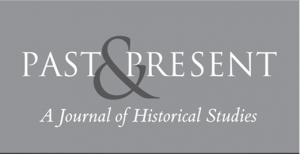by the Past & Present editorial team
February 2021 saw the publication of the 250th issue of Past & Present. To mark this occasion, the journal’s editors Prof. Matthew Hilton (Queen Mary, University of London) and Prof. Alexandra Walsham (Jesus College, University of Cambridge) followed in the practice established by their predecessors Christopher Hill, Rodney Hilton and Eric Hobsbawm in the 100th issue – published in August 1983 – and wrote a reflective Introduction to the issue. In it they set-out the journal’s place and purpose within the field of historical studies, survey the changing landscape including areas (such as a racial diversity, justice and inclusion) where historical studies must improve, and highlight and comment upon other initatives undertaken by the Society such as funding conferences and postdoctoral fellows.
The introduction begins:
“…Past and Present was founded as a generalist journal, covering all periods of history, from the ancient to the contemporary, and with an intention to cover all parts of the world. Our 250th issue does not quite fulfil that ambition, though the articles do stretch from the thirteenth century to the late twentieth and the geographical coverage reaches beyond Europe to Mongolia and south-east Asia. Articles, then as now, needed to be thoroughly grounded in deep historical research. Their findings also had to be not only accessible in style but have wider implications for non-specialists and for the wider audience beyond academia that the journal hoped to attract as its readers. It sought to do so by deliberately setting its subscriptions at affordable levels. It hoped its pages would be read by everyone interested in history, not simply by scholars sitting in their ivory towers.
This is still very much the case. The cost of an individual subscription to Past and Present remains surprisingly low for individuals and we have long pursued a policy of discounting the cost of institutional access for universities beyond the wealthy western world The most frequent editorial advice we continue to give to our authors is to push them to step outside their specialism and explain why the article matters to somebody who might work on a very different period and place. While we do not have a set formula for expressing such a requirement, the common instruction to ensure that the piece has conceptual, methodological or historiographical resonance beyond its immediate field lies behind nearly every letter we write encouraging resubmission (alongside, frequently, some further gentle pressure to disentangle an overly long convoluted title!).”
Alongside the Editor’s Introduction, the journal’s Board as a whole has curated a selection of (currently free to read) articles from each of the journal’s decades (spanning 1952 to 2020) to produce a “Virtual Issue” which serves a Past & Present reader giving a sense of how the journal has both changed with the times and remained grounded in it’s founding principals.
These can be found here, alongside a brief commentatary on each piece from an Editorial Board member.

